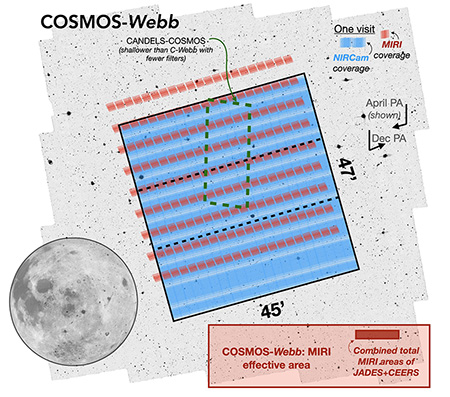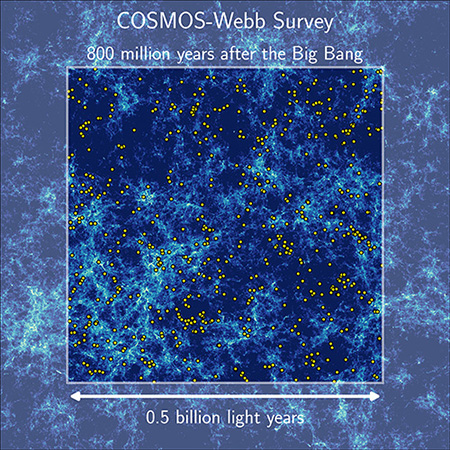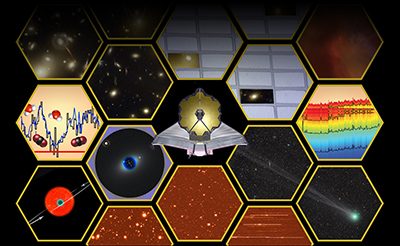Campus News
James Webb Space Telescope program aims to map the earliest structures of the universe
COSMOS-Webb is slated to be the largest program in JWST’s first year of operation.



When the James Webb Space Telescope (JWST) becomes operational in 2022, one of its first orders of business will be mapping the earliest structures of the universe. A team of nearly 50 researchers, including UC Santa Cruz astronomers Brant Robertson and Nicole Drakos, will attempt to do this through the COSMOS-Webb program, the largest general observer program selected for JWST’s first year.
Over the course of 208.6 observing hours, the COSMOS-Webb program will conduct an ambitious survey of half a million galaxies with multi-band, high-resolution near infrared imaging and an unprecedented 32,000 galaxies in mid infrared. Led by scientists at Rochester Institute of Technology (RIT) and University of Texas at Austin, the COSMOS-Webb program will rapidly release data to the public so it can lead to countless other studies by other researchers.
The COSMOS field was originally imaged by the Cosmic Evolution Survey (COSMOS) project using the Hubble Space Telescope (HST), and additional observations have been made in the COSMOS field with a variety of other telescopes.
“COSMOS is one of the premier fields in extragalactic astronomy, the largest contiguous field ever imaged by the Hubble Space Telescope, but there’s a huge undiscovered space in COSMOS that has not yet been exploited in infrared,” explained Robertson, a professor of astronomy and astrophysics at UC Santa Cruz. “JWST observes in infrared wavelengths, and it’s very sensitive because it has a larger mirror than HST. By going further into the infrared, we can see galaxies at higher redshifts, which means further back in time, and because it is so sensitive we can see smaller and fainter galaxies.”
“The sheer scope of our program is so exciting,” said principal investigator Jeyhan Kartaltepe at RIT’s School of Physics and Astronomy. “The first year of Webb observations will result in a lot of new discoveries that people will want explore more in-depth in future cycles. I think the public legacy of COSMOS-Webb will be that COSMOS will be the field where the community conducts this type of follow-up research.”
The survey will map 0.6 square degrees of the sky—about the area of three full moons—using JWST’s Near Infrared Camera (NIRCam) instrument, while simultaneously mapping a smaller area of 0.2 square degrees with the Mid Infrared Instrument (MIRI). Through this approach, the scientists hope to achieve three main goals.
The first goal focuses on the epoch of reionization, which took place from 400,000 to 1 billion years after the big bang. When the first stars and galaxies formed, they provided energy to re-ionize the early universe, and it likely happened in little pockets, not all at once. COSMOS-Webb aims to map out the scale of these reionization bubbles.
A second goal is to use the MIRI instrument to look for fully evolved galaxies at high redshifts that seemingly matured soon after the universe formed. HST has found examples of these galaxies, which challenge existing models about how the universe formed, so the hope is to find more examples of these high redshift galaxies and study them in more detail to understand how they could have evolved so rapidly.
The third primary objective makes use of a technique called weak lensing. Because gravity is sensitive to all kinds of matter, including invisible dark matter, scientists can use the distortions of light around galaxies to estimate of the amount of dark matter. COSMOS-Webb will provide important insight about how dark matter in galaxies has evolved with the stellar content of galaxies over the age of the universe.
Drakos, a postdoctoral scholar working with Robertson at UCSC, played a crucial role in the planning for COSMOS-Webb, using cosmological simulations to predict what JWST would see at different distances. Those predictions showed how JWST can be used to map the distribution of galaxies in the early universe.
“We’re interested in looking at the emergence of large-scale structure in the early universe and the distribution of galaxies during reionization, and Dr. Drakos’s calculations showed how to find those high-redshift structures,” Robertson said.
Principal investigator Caitlin Casey at UT Austin said, “COSMOS-Webb has the potential to be groundbreaking in ways we haven’t even dreamt yet. You don’t know what treasures are there to find until you use an incredible telescope like Webb to stare at the sky for a long time.”
COSMOS-Webb is one of just 286 General Scientific Observer programs selected out of more than 1,000 proposals for the telescope’s first year of science, known as Cycle 1. These specific programs will provide the worldwide astronomical community with one of the first extensive opportunities to investigate scientific targets with Webb. NASA is currently targeting October 31, 2021, for JWST’s launch.
For more information about COSMOS-Webb, go to the Space Telescope Science Institute website.